Richard A.Brualdi 组合数学习题解答
3.2组合数及其性质教案-2023-2024学年高二上学期数学北师大版(2019)选择性必修第一册
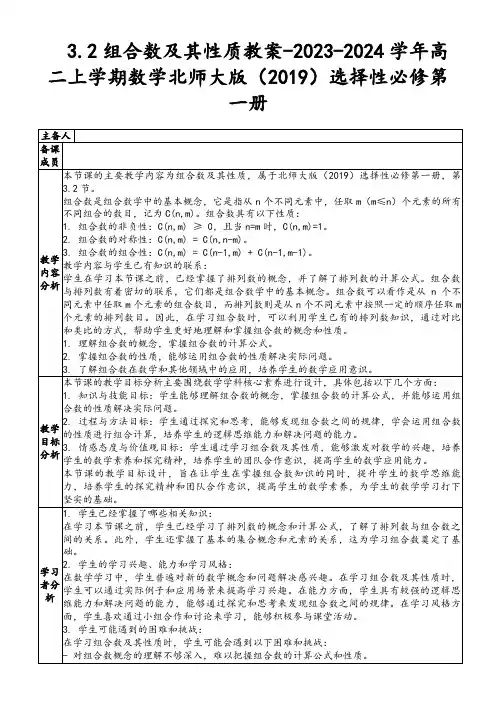
6. 教学指导书:为学生提供一本教学指导书,其中包括本节课的学习目标、教学内容、学习方法、练习题和答案等,以便学生能够更好地学习本节课的内容。
作用和目的:通过拓展练习和数学活动,帮助学生深入理解和应用组合数及其性质,提高学生的数学应用能力。
拓展与延伸
1. 提供与本节课内容相关的拓展阅读材料:
《组合数学导论》(作者:Richard A. Brualdi,ISBN:978-0-521-57498-1)
《概率论与数理统计》(作者:李尚志,ISBN:978-7-04-038045-0)
3.2组合数及其性质教案-2023-2024学年高二上学期数学北师大版(2019)选择性必修第一册
主备人
备课成员
教学内容分析
本节课的主要教学内容为组合数及其性质,属于北师大版(2019)选择性必修第一册,第3.2节。
组合数是组合数学中的基本概念,它是指从n个不同元素中,任取m(m≤n)个元素的所有不同组合的数目,记为C(n,m)。组合数具有以下性质:
板书设计
1. 组合数的定义与计算公式
- 定义:组合数是从n个不同元素中,任取m(m≤n)个元素的所有不同组合的数目,记为C(n,m)。
- 计算公式:C(n,m) = n! / [m!(n-m)!]。
2. 组合数的性质
- 非负性:C(n,m) ≥ 0,且当n=m时,C(n,m)=1。
- 对称性:C(n,m) = C(n,n-m)。
2. 组合数的性质:组合数的非负性、对称性和组合性。
3. C(5,2) = 5! / [2!(5-2)!] = 10。
《组合数学》练习题一参考答案
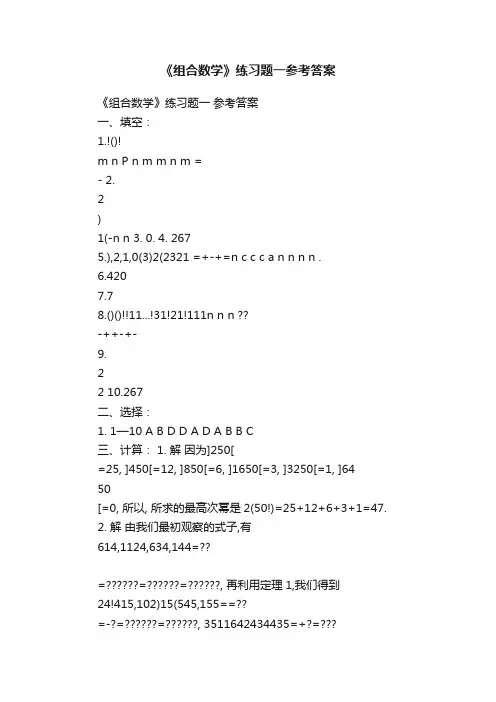
《组合数学》练习题一参考答案《组合数学》练习题一参考答案一、填空:1.!()!m n P n m m n m =- 2.2)1(-n n 3. 0. 4. 2675.),2,1,0(3)2(2321 =+-+=n c c c a n n n n .6.4207.78.()()!!11...!31!21!111n n n ??-++-+-9.22 10.267二、选择:1. 1—10 A B D D A D A B B C三、计算: 1. 解因为]250[=25, ]450[=12, ]850[=6, ]1650[=3, ]3250[=1, ]6450[=0, 所以, 所求的最高次幂是2(50!)=25+12+6+3+1=47.2. 解由我们最初观察的式子,有614,1124,634,144=??===, 再利用定理1,我们得到24!415,102)15(545,155==??=-?==, 3511642434435=+?=???+=, 5061141424425=+?=??+=. 所以,x x x x x x f 24503510)(23455+-+-=.3. 解:设所求为N ,令}2000,,2,1{ =S ,以A ,B ,C 分别表示S 中能被32?,52?,53?整除的整数所成之集,则53466663133200333 532200053220003532000522000322000 =+?-++=+-???????+???????+???????=+---++==C B A C B C A B A C B A CB A N 4. 解:记7个来宾为1A ,2A ,…,7A ,则7个来宾的取帽子方法可看成是由1A ,2A ,…,7A 作成的这样的全排列:如果i A (1≤i ≤7)拿了j A 的帽子,则把i A 排在第j 位,于是(1)没有一位来宾取回的是他自己的帽子的取法种数等于7元重排数7D ,即等于1854。
应用组合数学(答案)
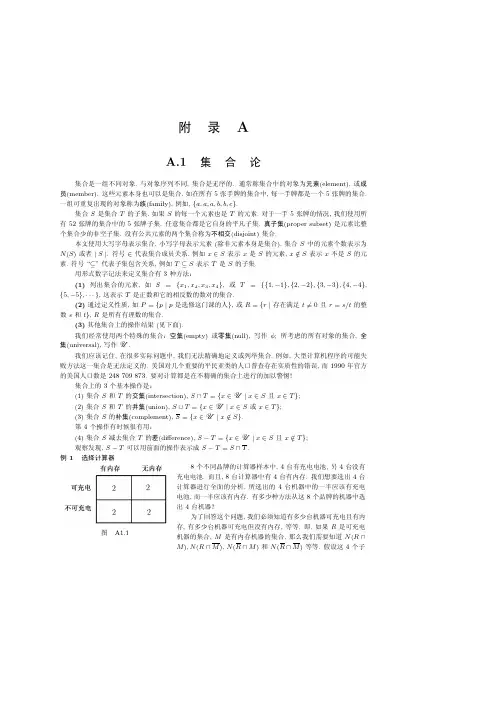
6. 对于图 A1.2a 的 Venn 图, 用每个区域所代表的集合的集合表达式来对该区域赋标签 (例如, 两个集 合的交的区域将会被标签为 A ∩ B).
7. 画出下列各集合的 Venn 图. (a) A − B. (b) A ∪ B. (c) (A ∪ B) ∩ (A ∩ B). (d) A − (B − A).
A.1 集 合 论 331
集中每一个都有两台机器. 参见图 A1.1. 那么选出 4 台机器的理想组合的策略之一是从图 A1.1 中的每一 个范畴中选出一台机器 (2×2×2×2=16 种选择). 从图 A1.1 中选出 4 台机器还有其他两种办法 (参见本节 末尾的练习 4).
涉及前述集合操作以及相关规则的集合表达式的研究称为布尔代数(Boolean algebra). 布尔代数的 3 个最重要的规则是
下面的集合表达式.
(a) (A ∪ B) ∩ (A ∩ B). (c) (A ∪ C) ∩ (A ∪ B) ∩ (B ∪ C).
(b) A − (B ∪ A).
(d) (A ∪ B) ∩ [(C ∪ B) − (A ∩ B)].
16. 假设投掷两枚骰子. 至少在一枚骰子上出现 1 或 2 的结果有多少种?
(b) {6, 10}. (d) {2, 7, 9}. (f ) {3, 5, 6, 7, 9, 10}.
3. 假设在例 1 中, 我们只知道这样的一条信息:两台计算器有内存但不可充电. 现在说明我们能够推出 图 A1.1 中其他 3 个盒子里的机器数量.
the 2 section---组合数学英文原版
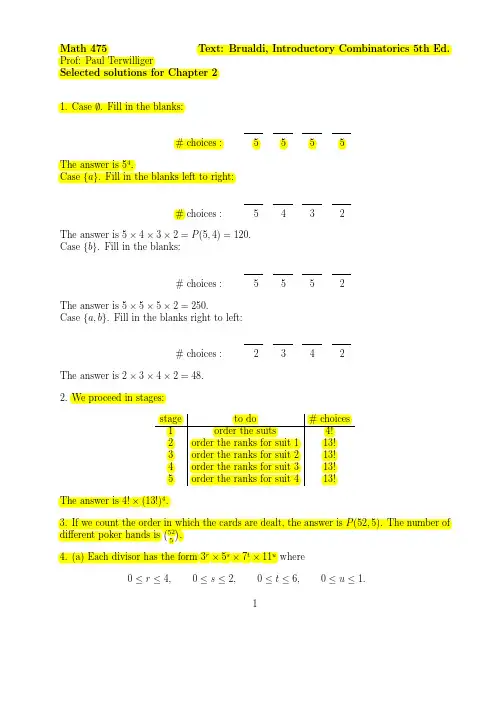
# committees +
9 2 9 2 11 2 11 3 9 1 11 3
+
9 1 9 1 11 3 11 4
9 0
11 4
++
+ +
+ +
9 0 9 0
11 4 11 5
The answer is the sum of the entries in the right-most column of the above table. 11. Let a < b < c denote the elements of the 3-integer set. Define x = a − 1, y = b − a − 2, z = c − b − 2, w = 20 − c.
The table shows that in the prime factorization of 50! the power of 5 is 12. In the prime factoriztion of 50! the power of 2 is clearly greater than 12, so the answer is 12. (b) Note that 1000 = 5 × 200. Therefore there exist 200 positive integers at most 1000 that are divisible by 5. Note that 200 = 5 × 40. Therefore there exist 40 positive integers at most 1000 that are divisible by 52 . Note that 40 = 5 × 8. Therefore there exist 8 positive integers at most 1000 that are divisible by 53 . Also 625 is the unique positive integer at most 1000 that is divisible by 54 . Therefore in the prime factorization of 1000! the power of 5 is 200 + 40 + 8 + 1 = 249. In the prime factorization of 1000! the power of 2 is greater than 249. Therefore the answer is 249. 6. Consider the set S of integers that meet the requirements. We find |S |. The maximal integer in S is 98654310, and this has 8 digits. The minimal integer in S is 5401, with 4 digits. For 4 ≤ n ≤ 8 let Sn denote the set of integers in S that have exactly n digits. By
Richard组合数学第5版-第5章课后习题答案(英文版)
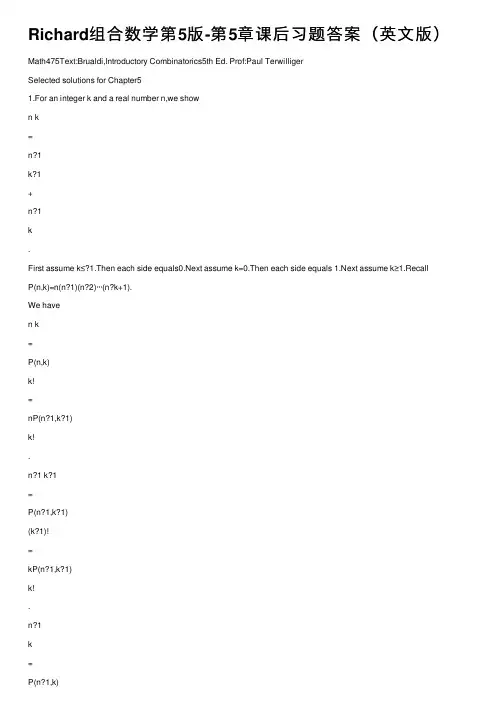
Richard组合数学第5版-第5章课后习题答案(英⽂版)Math475Text:Brualdi,Introductory Combinatorics5th Ed. Prof:Paul TerwilligerSelected solutions for Chapter51.For an integer k and a real number n,we shown k=n?1k?1+n?1k.First assume k≤?1.Then each side equals0.Next assume k=0.Then each side equals 1.Next assume k≥1.RecallP(n,k)=n(n?1)(n?2)···(n?k+1).We haven k=P(n,k)k!=nP(n?1,k?1)k!.n?1 k?1=P(n?1,k?1)(k?1)!=kP(n?1,k?1)k!.n?1k(n?k)P(n?1,k?1)k!.The result follows.2.Pascal’s triangle begins111121133114641151010511615201561172135352171182856705628811936841261268436911104512021025221012045101···13.Let Z denote the set of integers.For nonnegative n∈Z de?ne F(n)=k∈Zn?kk.The sum is well de?ned since?nitely many summands are nonzero.We have F(0)=1and F(1)=1.We show F(n)=F(n?1)+F(n?2)for n≥2.Let n be /doc/6215673729.htmling Pascal’s formula and a change of variables k=h+1,F(n)=k∈Zn?kk=k∈Zn?k?1k?1=k∈Zn?k?1k+h∈Zn?h?2h=F(n?1)+F(n?2).Thus F(n)is the n th Fibonacci number.4.We have(x+y)5=x5+5x4y+10x3y2+10x2y3+5xy4+y5and(x+y)6=x6+6x5y+15x4y2+20x3y3+15x2y4+6xy5+y6.5.We have(2x?y)7=7k=07k27?k(?1)k x7?k y k.6.The coe?cient of x5y13is35(?2)13 185.The coe?cient of x8y9is0since8+9=18./doc/6215673729.htmling the binomial theorem,3n=(1+2)n=nk=0nSimilarly,for any real number r,(1+r)n=nk=0nkr k./doc/6215673729.htmling the binomial theorem,2n=(3?1)n=nk=0(?1)knk3n?k.29.We haven k =0(?1)k nk 10k =(?1)n n k =0(?1)n ?k n k 10k =(?1)n (10?1)n =(?1)n 9n .The sum is 9n for n even and ?9n for n odd.10.Given integers 1≤k ≤n we showk n k =n n ?1k ?1.Let S denote the set of ordered pairs (x,y )such that x is a k -subset of {1,2,...,n }and yis an element of x .We compute |S |in two ways.(i)To obtain an element (x,y )of S there are n k choices for x ,and for each x there are k choices for y .Therefore |S |=k n k .(ii)Toobtain an element (x,y )of S there are n choices for y ,and for each y there are n ?1k ?1 choices for x .Therefore |S |=n n ?1k ?1.The result follows.11.Given integers n ≥3and 1≤k ≤n .We shown k ? n ?3k = n ?1k ?1 + n ?2k ?1 + n ?3k ?1.Let S denote the set of k -subsets of {1,2,...,n }.Let S 1consist of the elements in S thatcontain 1.Let S 2consist of the elements in S that contain 2but not 1.Let S 3consist of the elements in S that contain 3but not 1or 2.Let S 4consist of the elements in S that do|S |= n k ,|S 1|= n ?1k ?1 ,|S 2|= n ?2k ?1 ,|S 3|= n ?3k ?1 ,|S 4|= n ?3k .The result follows.12.We evaluate the sumnk =0(?1)k nk 2.First assume that n =2m +1is odd.Then for 0≤k ≤m the k -summand and the (n ?k )-summand are opposite.Therefore the sum equals 0.Next assume that n =2m is even.Toevaluate the sum in this case we compute in two ways the the coe?cient of x n in (1?x 2)n .(i)By the binomial theorem this coe?cient is (?1)m 2m m .(ii)Observe (1?x 2)=(1+x )(1?x ).We have(1+x )n =n k =0n k x k,(1?x )n =n k =0nk (?1)k x k .3By these comments the coe?cient of x n in(1?x2)n isn k=0nn?k(?1)knk=nk=0(?1)knk2.2=(?1)m2mm.13.We show that the given sum is equal ton+3k .The above binomial coe?cient is in row n+3of Pascal’s /doc/6215673729.htmling Pascal’s formula, write the above binomial coe?cient as a sum of two binomial coe?ents in row n+2of Pascal’s triangle.Write each of these as a sum of two binomial coe?ents in row n+1of Pascal’s triangle.Write each of these as a sum of two binomial coe?ents in row n of Pascal’s triangle.The resulting sum isn k+3nk?1+3nk?2+nk?3.14.Given a real number r and integer k such that r=k.We showr k=rr?kr?1k.First assume that k≤?1.Then each side is0.Next assume that k=0.Then each side is 1.Next assume that k≥1.ObserverP(r?1,k?1)k!,andr?1k=P(r?1,k)k!=(r?k)P(r?1,k?1)k!.The result follows.15.For a variable x consider(1?x)n=nk=0nk(?1)k x k.4Take the derivative with respect to x and obtain n(1x)n1=nk=0nk(?1)k kx k?1.Now set x=1to get(?1)k k.The result follows.16.For a variable x consider(1+x)n=nk=0nkx k.Integrate with respect to x and obtain(1+x)n+1 n+1=nk=0nkx k+1k+1+Cfor a constant C.Set x=0to?nd C=1/(n+1).Thus (1+x)n+1?1n+1=nk=0nkx k+1k+1.Now set x=1to get2n+1?1 n+1=k+1.17.Routine.18.For a variable x consider(x?1)n=nk=0nk(?1)n?k x k.Integrate with respect to x and obtain(x?1)n+1 n+1=nk=0nk(?1)n?kx k+1k+1+Cfor a constant C.Set x=0to?nd C=(?1)n+1/(n+1).Thus (x?1)n+1?(?1)n+1n+1=nk=0nk(?1)n?kx k+1k+1Now set x =1to get(?1)n n +1=n k =0n k(?1)n ?k 1k +1.Therefore1n +1=n k =0 n k (?1)k 1k +1 .19.One readily checks2 m 2 + m 1=m (m ?1)+m =m 2.Therefore n k =1k 2=nk =0k 2=2nk =0 k 2 +n k =0k1=2 n +13 +n +12 =(n +1)n (2n +1)6.20.One readily checksm 3=6 m 3 +6 m 2 + m1.Thereforen k =1k3=n=6nk =0 k3+6n k =0 k2 +n k =0k1 =6 n +14 +6 n +13 +n +12 =(n +1)2n 24= n +12 2.621.Given a real number r and an integer k .We showrk=(?1)kr +k ?1k .First assume that k <0.Then each side is zero.Next assume that k ≥0.Observe r k =(r )(r 1)···(r k +1)k !=(?1)kr (r +1)···(r +k ?1)k !=(?1)kr +k ?1k.22.Given a real number r and integers k,m .We showr m m k = r k r ?km ?k.First assume that mObserver m m k =r (r ?1)···(r ?m +1)m !m !k !(m ?k )!=r (r ?1)···(r ?k +1)k !(r ?k )(r ?k ?1)···(r ?m +1)(m ?k )!= r k r ?k m ?k .23.(a) 2410.(b) 94 156.(c) 949363.(d)94156949363.24.The number of walks of length 45is equal to the number of words of length 45involving10x ’s,15y ’s,and 20z ’s.This number is45!10!×15!×20!.725.Given integers m 1,m 2,n ≥0.Shown k =0m 1k m 2n ?k = m 1+m 2n .Let A denote a set with cardinality m 1+m 2.Partition A into subsets A 1,A 2with cardinalitiesm 1and m 2respectively.Let S denote the set of n -subsets of A .We compute |S |in two ways.(i)By construction|S |= m 1+m 2n .(ii)For 0≤k ≤n let the set S k consist of the elements in S whose intersection with A 1has cardinality k .The sets {S k }n k =0partition S ,so |S |= nk =0|S k |.For 0≤k ≤n we now compute |S k |.To do this we construct an element x ∈S k via the following 2-stage procedure: stage to do #choices 1pick x ∩A 1 m 1k2The number |S k |is the product of the entries in the right-most column above,which comes to m 1k m 2n ?k .By these comments |S |=n k =0m 1k m 2n ?k .The result follows.26.For an integer n ≥1shown k =1 n k n k ?1 =12 2n +2n +1 ? 2n n .Using Problem 25,n k =1 n k nk ?1 =n k =0n k n k ?1 =n k =0n k nn +1?k =2n n +1 =12 2n n ?1 +12 2n n +1.8It remains to show12 2nn ?1 +12 2n n +1 =12 2n +2n +1 ? 2n n.This holds since2n n ?1 +2 2n n + 2n n +1 = 2n +1n +2n +1n +1= 2n +2n +1.27.Given an integer n ≥1.We shown (n +1)2n ?2=nk =1Let S denote the set of 3-tuples (s,x,y )such that s is a nonempty subset of {1,2,...,n }and x,y are elements (not necessarily distinct)in s .We compute |S |in two ways.(i)Call an element (s,x,y )of S degenerate whenever x =y .Partition S into subsets S +,S ?with S +(resp.S ?)consisting of the degenerate (resp.nondegenerate)elements of S .So |S |=|S +|+|S ?|.We compute |S +|.To obtain an element (s,x,x )of S +there are n choices for x ,and given x there are 2n ?1choices for s .Therefore |S +|=n 2n ?1.We compute |S ?|.To obtain an element (s,x,y )of S ?there are n choices for x,and given x there are n ?1choices for y ,and given x,y there are 2n ?2choices for s .Therefore |S ?|=n (n ?1)2n ?2.By these comments|S |=n 2n ?1+n (n ?1)2n ?2=n (n +1)2n ?2.(ii)For 1≤k ≤n let S k denote the set of elements (s,x,y )in S such that |s |=k .Thesets {S k }nk =1give a partition of S ,so |S |= n k =1|S k |.For 1≤k ≤n we compute |S k |.To obtain an element (s,x,y )of S k there are n k choices for s ,and given s there are k 2ways to choose the pair x,y .Therefore |S k |=k 2 nk .By these comments|S |=n k =1k 2 n k .The result follows.28.Given an integer n ≥1.We shown k =1k n k 2=n 2n ?1n ?1 .Let S denote the set of ordered pairs (s,x )such that s is a subset of {±1,±2,...,±n }andx is a positive element of s .We compute |S |in two ways.(i)To obtain an element (s,x )of S There are n choices for x ,and given x there are 2n ?1n ?1 choices for s .Therefore|S |=n 2n ?1n ?1.9(ii)For1≤k≤n let S k denote the set of elements(s,x)in S such that s contains exactlyk positive elements.The sets{S k}nk=1partition S,so|S|=nk=1|S k|.For1≤k≤nwe compute|S k|.To obtain an element(s,x)of S k there are nkways to pick the positiveelements of s and nn?kways to pick the negative elements of s.Given s there are kways to pick x.Therefore|S k|=k nk2.By these comments |S|=nk=1knk2.The result follows.29.The given sum is equal tom2+m2+m3n .To see this,compute the coe?cient of x n in each side of(1+x)m1(1+x)m2(1+x)m3=(1+x)m1+m2+m3.In this computation use the binomial theorem.30,31,32.We refer to the proof of Theorem5.3.3in the text.Let A denote an antichain such that|A|=nn/2.For0≤k≤n letαk denote the number of elements in A that have size k.Sonk=0αk=|A|=nn/2.As shown in the proof of Theorem5.3.3,≤1,with equality if and only if each maximal chain contains an element of A.By the above commentsnk=0αknn/2nknk≤0,with equality if and only if each maximal chain contains an element of A.The above sum is nonpositive but each summand is nonnegative.Therefore each summand is zero and the sum is zero.Consequently(a)each maximal chain contains an element of A;(b)for0≤k≤n eitherαk is zero or its coe?cient is zero.We now consider two cases.10Case:n is even.We show that for0≤k≤n,αk=0if k=n/2.Observe that for0≤k≤n, if k=n/2then the coe?cient ofαk isnonzero,soαk=0.Case:n is odd.We show that for0≤k≤n,eitherαk=0if k=(n?1)/2orαk=0 if k=(n+1)/2.Observe that for0≤k≤n,if k=(n±1)/2then the coe?cient ofαk is nonzero,soαk=0.We now show thatαk=0for k=(n?1)/2or k=(n+1)/2. To do this,we assume thatαk=0for both k=(n±1)/2and get a contradiction.By assumption A contains an element x of size(n+1)/2and an element y of size(n?1)/2. De? ne s=|x∩y|.Choose x,y such that s is maximal.By construction0≤s≤(n?1)/2. Suppose s=(n?1)/2.Then y=x∩y?x,contradicting the fact that x,y are incomparable. So s≤(n?3)/2.Let y denote a subset of x that contains x∩y and has size(n?1)/2. Let x denote a subset of y ∪y that contains y and has size(n+1)/2.By construction |x ∩y|=s+1.Observe y is not in A since x,y are comparable.Also x is not in A by the maximality of s.By construction x covers y so they are together contained in a maximal chain.This chain does not contain an element of A,for a contradiction.33.De?ne a poset(X,≤)as follows.The set X consists of the subsets of{1,2,...,n}. For x,y∈X de?ne x≤y whenever x?y.Forn=3,4,5we display a symmetric chain decomposition of this poset.We use the inductive procedure from the text.For n=3,,1,12,1232,233,13.For n=4,,1,12,123,12344,14,1242,23,23424,For n=5,,1,12,123,1234,123455,15,125,12354,14,124,124545,1452,23,234,234525,23524,2453,13,134,134535,13534,345.1134.For 0≤k ≤ n/2 there are exactlyn kn k ?1symmetric chains of length n ?2k +1.35.Let S denote the set of 10jokes.Each night the talk show host picks a subset of S for his repertoire.It is required that these subsets form an antichain.By Corollary 5.3.2each antichain has size at most 105 ,which is equal to 252.Therefore the talk show host can continue for 252nights./doc/6215673729.htmlpute the coe?cient of x n in either side of(1+x )m 1(1+x )m 2=(1+x )m 1+m 2,In this computation use the binomial theorem.37.In the multinomial theorem (Theorem 5.4.1)set x i =1for 1≤i ≤t .38.(x 1+x 2+x 3)4is equal tox 41+x 42+x 43+4(x 31x 2+x 31x 3+x 1x 32+x 32x 3+x 1x 33+x 2x 33)+6(x 21x 22+x 21x 23+x 22x 23)+12(x 21x 2x 3+x 1x 22x 3+x 1x 2x 23).39.The coe?cient is10!3!×1!×4!×0!×2!which comes to 12600.40.The coe?cient is9!3!×3!×1!×2!41.One routinely obtains the multinomial theorem (Theorem 5.4.1)with t =3.42.Given an integer t ≥2and positive integers n 1,n 2,...,n t .De?ne n = ti =1n i .We shownn 1n 2···n t=t k =1n ?1n 1···n k ?1n k ?1n k +1···n t.Consider the multiset{n 1·x 1,n 2·x 2,...,n t ·x t }.Let P denote the set of permutations of this multiset.We compute |P |in two ways.(i)We saw earlier that |P |=n !n 1!×n 2!×···×n t != n n 1n 2···n t.12(ii)For1≤k≤t let P k denote the set of elements in P that have?rst coordinate x k.Thesets{P k}tk=1partition P,so|P|=tk=1|P k|.For1≤k≤t we compute|P k|.Observe that|P k|is the number of permutations of the multiset{n1·x1,...,n k?1·x k?1,(n k?1)·x k,n k+1·x k+1,...,n t·x t}. Therefore|P k|=n?1n1···n k?1n k?1n k+1···n t.By these comments|P|=tn1···n k?1n k?1n k+1···n t.The result follows.43.Given an integer n≥1.Show by induction on n that1 (1?z)n =∞k=0n+k?1kz k,|z|<1.The base case n=1is assumed to hold.We show that the above identity holds with n replaced by n+1,provided that it holds for n.Thus we show1(1?z)n+1=∞=0n+z ,|z|<1.Observe1(1?z)n+1=1(1?z)n11?z=∞k=0n+k?1kz k∞h=0z h=0c zwherec =n?1+n1+n+12+···+n+ ?1=n+.The result follows.1344.(Problem statement contains typo)The given sum is equal to (?3)n .Observe (?3)n =(?1?1?1)n=n 1+n 2+n 3=nnn 1n 2n 3(?1)n 1+n 2+n 3=n 1+n 2+n 3=nnn 1+n 2+n 3=nnn 1n 2n 3(?1)n 2.45.(Problem statement contains typo)The given sum is equal to (?4)n .Observe (?4)n =(?1?1?1?1)n=n 1+n 2+n 3+n 4=nnn 1n 2n 3n 4(?1)n 1+n 2+n 3+n 4=n 1+n 2+n 3+n 4=nnn 1n 2n 3n 4(?1)n 1?n 2+n 3?n 4.Also0=(1?1+1?1)n= n 1+n 2+n 3+n 4=nnn 1n 2n 3n 4(?1)n 2+n 4.46.Observe√30=5=5∞ k =01/2k z k.For n =0,1,2,...the n th approximation to √30isa n =5n k =0 1/2k 5?k.We have14n a n051 5.52 5.4753 5.47754 5.47718755 5.477231256 5.4772246887 5.4772257198 5.4772255519 5.477225579 47.Observe101/3=21081/3=2(1+z)1/3z=1/4,=2∞k=01/3kz k.For n=0,1,2,...the n th approximation to101/3isnk=01/3k4?k.We haven a n021 2.1666666672 2.1527777783 2.1547067904 2.1543852885 2.1544442306 2.1544327697 2.1544350898 2.1544346059 2.15443470848.We show that a poset with mn+1elements has a chain of size m+1or an antichain of size n+1.Our strategy is to assume the result is false,and get a contradiction.By assumption each chain has size at most m and each antichain has size at most n.Let r denote the size of the longest chain.So r≤m.By Theorem5.6.1the elements of the posetcan be partitioned into r antichains{A i}ri=1.We have|A i|≤n for1≤i≤r.Thereforemn+1=ri=1|A i|≤rn≤mn, 15for a contradiction.Therefore,the poset has a chain of size m+1or an antichain of size n+1.49.We are given a sequence of mn+1real numbers,denoted{a i}mni=0.Let X denote the setof ordered pairs{(i,a i)|0≤i≤mn}.Observe|X|=mn+1.De?ne a partial order≤on X as follows:for distinct x=(i,a i)and y=(j,a j)in X,declare xof{a i}mni=0,and the antichains correspond to the(strictly)decreasing subsequences of{a i}mni=0sequence{a i}mni=0has a(weakly)increasing subsequence of size m+1or a(strictly)decreasingsubsequence of size n+1.50.(i)Here is a chain of size four:1,2,4,8.Here is a partition of X into four antichains:8,124,6,9,102,3,5,7,111Therefore four is both the largest size of a chain,and the smallest number of antichains that partition X. (ii)Here is an antichain of size six:7,8,9,10,11,12.Here is a partition of X into six chains:1,2,4,83,6,1295,10711Therefore six is both the largest size of an antichain,and the smallest number of chains that partition X.51.There exists a chain x116。
《组合数学》第五版 第6章答案.pdf
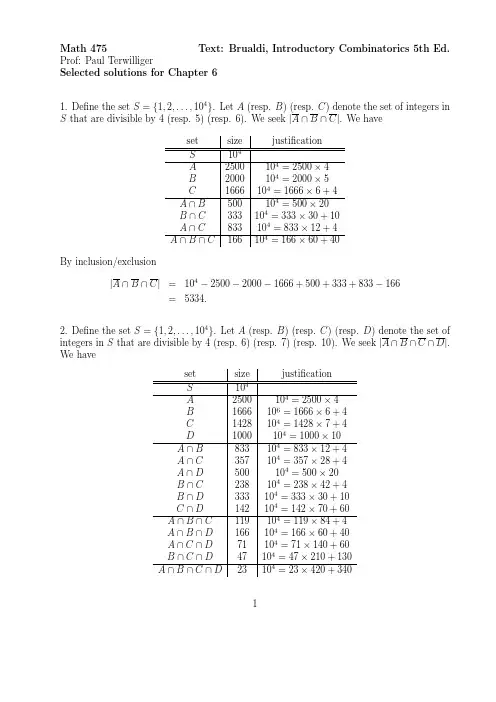
set size
justification
S
13 4
13 = 14 − 5 + 5 − 1
Ai
8 4
13 − 5 = 8
Ai ∩ Aj 0 13 − 5 − 5 = 3 < 4
By inclusion/exclusion
13
8
|A1 ∩ A2 ∩ A3 ∩ A4 ∩ A5| =
4
− 5 = 365. 4
set size
justification
S
17 3
17 = 14 + 4 − 1
Ai
8 3
17 − 9 = 8
Ai ∩ Aj 0 17 − 9 − 9 = −1 < 3
By inclusion/exclusion
17
8
|A1 ∩ A2 ∩ A3 ∩ A4| =
3
− 4 = 456. 3
8. Let S denote the set of positive integral solutions for x1 + x2 + x3 + x4 + x5 = 14. For 1 ≤ i ≤ 5 let Ai denote the set of elements in S with xi ≥ 6. We seek |A1 ∩A2 ∩A3 ∩A4 ∩A5|. We have
X∩Y ∩Z
0
15 − 5 − 4 − 5 = 1 < 3
X∩Y ∩W 0
15 − 5 − 4 − 6 = 0 < 3
X ∩Z ∩W
0 15 − 5 − 5 − 6 = −1 < 3
Y ∩Z∩W
0
抽屉原理的构造及其应用
抽屉原理的构造及其应用抽屉原理的构造及其应用摘要:抽屉原理是组合数学中最基本的计数原理之一,抽屉原理是组合数学中最基本的计数原理之一,是处理存在性问题的一个是处理存在性问题的一个重要方法,本文主要介绍抽屉原理的几个构造方法以及一些应用。
关键词:抽屉原理、构造、应用。
:抽屉原理、构造、应用。
抽屉原理抽屉原理 将m 个物品放入n 个抽屉,则至少有一个抽屉中的物品个数不少于[(m-1/n]+1个,其中m-1/n 向下取整向下取整由此可知,在利用抽屉原理解题时,首先要明确哪些是“物品”,哪些是“抽屉”,而这两者通常不会现存于题目中,尤其是抽屉,这个往往需要我们用一些巧妙的方法去构造,下面举例说明常见的抽屉构造方法。
1、 利用分割图形的方法构造抽屉利用分割图形的方法构造抽屉本方法主要用于解决点在几何图形中的位置分布和性质问题,通常我们把一个几何图形分割成几部分,然后把每一部分当做一个“抽屉”,每个抽屉里放入相应的元素.通常情况下,我们分割图形构造抽屉的最好方法是等分这个几何图形。
例1:从边长为:从边长为22的正方形中任选的正方形中任选55个点,则它们当中存在两个点,这两个点之间的距离至多为的距离至多为1.4. 1.4.证明:将此正方形分割成将此正方形分割成44个边长为个边长为11的小正方形。
当有两点位于其中一个小正方形时,这两个点之间的距离不会超过小正方形对角线的长度1.4.1.4.由抽屉原理知,由抽屉原理知,5个点中必至少有两个点位于一个小正方形中。
2、 利用划分数组的方法来构造抽屉利用划分数组的方法来构造抽屉利用此方法解题的关键是要明确分组的利用此方法解题的关键是要明确分组的“对象”“对象”“对象”,,然后将这些对象分成适当的数组。
再应用抽屉原理,问题便得以解决。
例2:由小于:由小于100100100的的2727个不同的奇数组成的集合中,必有两个数其和为个不同的奇数组成的集合中,必有两个数其和为102. 证明:将小于证明:将小于100100100的奇数分为的奇数分为的奇数分为262626个组(抽屉):个组(抽屉):个组(抽屉):{3,99}{3,99}{3,99}、、{5,97}…{49,53} 因为有因为有272727个奇数,个奇数,个奇数,把它看作物品,把它看作物品,把它看作物品,由抽屉原理可知,由抽屉原理可知,由抽屉原理可知,必有两个奇数落在同一抽屉必有两个奇数落在同一抽屉中,这两个数之和恰好为中,这两个数之和恰好为102. 102.例3:任意给定:任意给定77个不同的整数,求证:其中必有两数之和或差是lO lO的倍数.的倍数.的倍数. 证明:设这证明:设这77个不同的整数分别为,个不同的整数分别为,a0a0…a ,它们分别除以,它们分别除以101010后。
Richard组合数学第5版-第5章课后习题答案(英文版)
evaluate the sum in this case we compute in two ways the the coefficient of xn in (1−x2)n. (i)
By the binomial theorem this coefficient is (−1)m
2m m
.
(ii) Observe (1 − x2) = (1 + x)(1 − x).
5
Now set x = 1 to get Therefore
(−1)n n =
n (−1)n−k 1 .
n+1
k
k+1
k=0
1
n
=
n (−1)k 1 .
n+1
k
k+1
k=0
19. One readily checks
m 2
+
m
= m(m − 1) + m = m2.
2
1
Therefore
n
n
k2 =
not contain 1 or 2 or 3. Note that {Si}4i=1 partition S so |S| =
4 i=1
|Si|.
We
have
n
n−1
n−2
n−3
n−3
|S| =
, k
|S1| =
, k−1
|S2| =
, k−1
|S3| =
, k−1
|S4| =
. k
The result follows.
We have
n P (n, k) nP (n − 1, k − 1)
=
组合数学第四版(RichardA.Brualdi著)机械工业出版社课后答案1
第2章 鸽巢原理2.4 练习题1、关于本节中的应用4,证明对于每一个1,2,…,21存在连续若干天,在此期间国际象棋大师将恰好下完局棋(情形21是在应用4中处理的情况)。
能否判断:存在连续若干天,在此期间国际象棋大师将恰好下完22局棋?=k k =k 证明:设表示在前天下棋的总数i a i 若正好有=,则命题得证。
若不然,如下:i a k ∵共有11周,每天至少一盘棋,每周下棋不能超过12盘∴有 ,且771≤≤i 13217721≤<<<≤a a a{}21,,2,1 ∈∀k 有k k a k a k a k +≤+<<+<+≤+13217721观察以下154个整数:k a k a k a a a a +++77217721,,,,,,,每一个数是1到之间的整数,其中k +132153132≤+k由鸽巢原理,这154个数中至少存在两个相等的数∵都不相等,7721,,,a a a k a k a k a +++7721,,, 都不相等∴j i ,∃,使=i a k a j +即这位国际象棋大师在第,1+j 2+j ,…,天总共下了盘棋。
i k 综上所述,对于每一个1,2,…,21存在连续若干天,在此期间国际象棋大师将恰好下完局棋。
=k k □当=22时,132+=154,那么以下154个整数k k 22,,22,22,,,,77217721+++a a a a a a在1到154之间。
ⅰ)若这154个数都不相同则它们能取到1到154的所有整数,必然有一个数是22∵,2222>+i a 771≤≤i∴等于22的数必然是某个,i a 771≤≤i则在前天,这位国际象棋大师总共下了22盘棋。
i ⅱ)若这154个数中存在相同的两个数∵都不相等,7721,,,a a a k a k a k a +++7721,,, 都不相等∴j i ,∃,使=i a k a j +即这位国际象棋大师在第,1+j 2+j ,…,天总共下了盘棋。
组合数学(Richard A. Brualdi)重要知识考点
第一章 什么是组合§1 排列组合组合数学主要研究有限集合的计数,结构的存在性,以及性质。
几个计数原理设A 是有限多个元素的集合,用A 表示A 的元素个数a) 分类与加法原理设12=r A A A A …,i j A A =∅ ,i j ≠,则称{}1i A i r ≤≤为A 的一个分类,显然1=rii A A=∑(加法原理)b) 分步骤乘法原理设12r A A A 、、…是有限集令{}12123=(,,)|,1r r i i B A A A a a a a a A i r ⨯⨯⨯=∈≤≤…,…,(笛卡尔乘积),称B 为12r A A A ,,…,的积,显然B 的每个元素123(,,)r a a a a ,…,是有序数对,是按步骤确定的且1=rii B A=∏(乘法原理)【例1】{}{}121,2,3,4,A A ==则(){}121,3,(2,4),(1,4),(2,4)A A ⨯= 【例2】求120的因数的个数解:3120=235⨯⨯,312|120235aaan n ∴⇔=⋅⋅,其中12303,01,01a a a ≤≤≤≤≤≤ 令{}{}{}1230,1,2,3,0,1,0,1A A A ===,记120的因数的集合为B 故123||=||=422=16B A A A ⨯⨯⨯⨯.【例3】有限集{}123n a a a a , , ,…,的一个有序列123r i i i i a a a a , , ,…,称为123n a a a a , , ,…,的一个r 排列,其中i j a a ≠,i j ≠,所有r 排列的个数记为(,)(1)(1)P n r n n n r =--+……,令(,)!P n n n =,则!(,)()!n P n r n r =-,规定:0!=1.c) 双射原理设A 、B 是两个集合,对应:f A B →,对A 中的每个元素a ,有唯一的元素()b f a =,a D ∈,与之对应,则称f 为一个映射.映射:srr→→不是映射.1. 如果1212,(),a a A a a ∀∈≠有12()()f a f a ≠,则称f 是单射.显然,这时有A B ≤.2. 如果,b B ∀∈有,a A ∈使(),f a b =则称f 为满射.3. 如果f 既是单射又是满射,则称f 为双射.这时=A B .【例4】设{}123r A a a a a = , , ,…,,计算A 的所有子集的个数(组合证明) 解:设B 表示A 的所有子集所成的子集(或者用幂集2A表示) 设f :{}{}{}{}0,10,10,10,1r B →⨯⨯⨯个……令x B ∈,123={}t i i i i x a a a a , , ,…,,1t r ≤≤,=0t 时表示∅,121t i i r ≤≤≤≤≤…i 12()(0000),t i i i f x =⋅⋅⋅⋅⋅⋅⋅⋅⋅⋅⋅⋅111如果=0x ,则令()(000)f x =⋅⋅⋅⋅⋅⋅ 易知f 是双射.由双射原理和乘法原理得:=2r B 补充:例如{}1,2A =,{}{1}{2}{1,2}B =∅,,,在上述映射下,有={0,1}{0,1}B ⨯,()(0,0)f ∅=,({1})(1,0)f =,({2})(0,1)f = 【例5】{}123n a a a a , , ,…,的r 个元素所成的集合成为A 的一个r 组合所有这样的r 组合的个数记为(,)!n P n r r r ⎛⎫= ⎪⎝⎭,称之为二项式系数.一般来讲0r ≥,特别的当=0r 时,10n ⎛⎫= ⎪⎝⎭,今后,令(1)(1)!x x x x r r r ⎛⎫-⋅⋅⋅-+= ⎪⎝⎭,0r ≥且x 为任意实数. 注意12!是没有意义的.【例6】 1)!(0)!()!n n n n r r r n r ⎛⎫=≥≥ ⎪-⎝⎭为正整数, 2)()n n r n r ⎛⎫⎛⎫= ⎪ ⎪-⎝⎭⎝⎭对称性 3)111n n n r r r --⎛⎫⎛⎫⎛⎫=+ ⎪ ⎪ ⎪-⎝⎭⎝⎭⎝⎭ 4) ++201nn n n n ⎛⎫⎛⎫⎛⎫= ⎪ ⎪ ⎪⎝⎭⎝⎭⎝⎭……循环排列(圆排列):从{}123n a a a a , , ,…,中取出r 个元素作圆排列的个数为(,)!=()!P n r n r r n r -,当n r =时,!(1)!n n n =-如:1,2,3三个元素作圆排列,一共有3!23=种不同的排列方法.§3 重集设123k a a a a , , ,…,是个不同的元素,我们用{}1122k k n a n a n a ⋅⋅⋅ , ,…,表示有1122k k n a n a n a 个 ,个 ,…,个的集合称为一个重集,这里0(1)i n i k ≤≤∞≤≤ 注:=0i n 表示i a 不出现,=i n ∞表示i a 取之不尽这个集合的r 元子集称为一个r 组合,r 元有序集合称为一个r 排列.【例1】{}123231a a a ⋅⋅⋅ , ,的5组合有:{}1223a a ⋅⋅ ,、{}12321a a a ⋅⋅⋅ ,2 ,、{}123131a a a ⋅⋅⋅ ,,3个;6排列共有6!60231=⋅⋅!!!个.§4 重集的排列a){}12k a a a ∞⋅∞⋅∞⋅ , ,…,的n 排列的个数等同于{}12k n a n a n a ⋅⋅⋅ , ,…,的n 排列的个数=n kb){}1122k k n a n a n a ⋅⋅⋅ , ,…,的全排列(这里1i n ≤≤∞)的个数为1212!k k n n n n n n n n ⎛⎫ ⎪⎝⎭…!!…!,其中1ki i n n ==∑ 注:12k n n n n ⎛⎫⎪⎝⎭…称为多项式系数,这里只有当12k n n n n =+++…时才有意义.证明:要得到{}1122k k n a n a n a ⋅⋅⋅ , ,…,一个n 排列,我们只需从n 个有序位置中选取1n 个位置来放1a ,共有1n n ⎛⎫⎪⎝⎭种方法,再在余下的1n n -个位置中选2n 个位置来放2a ,共有12n n n -⎛⎫⎪⎝⎭种方法,继续下去,由乘法原理,n 排列的个数等于12121131212111211212312312112)!()!()!!!()!!()!!()!()!!k k k k k k k n n n n n n n n n n n n n n n n n n n n n n n n n n n n n n n n n n n n n n n n n n n n n n ----------⎛⎫⎛⎫⎛⎫⎛⎫⎪ ⎪ ⎪⎪⎝⎭⎝⎭⎝⎭⎝⎭-------=⋅⋅-----------=………(…………!!…!c) 多重集合的组合。
